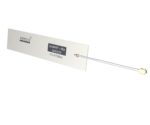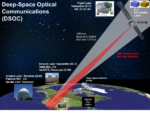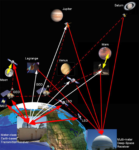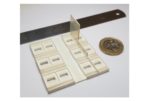ThinKom Solutions, Inc. unveiled a new Ka-band phased-array satellite antenna for communications-on-the-move (COTM) applications. The new ThinSat Ka500, based on ThinKom’s proven VICTS technology, is a “turnkey” terminal that enables the user to easily and quickly connect to the network of their choice, such as the existing and new Ka-band networks being deployed using satellites in geostationary […]
Wireless
What are reflectionless filters? Part 1: context
Standard filters reflect unwanted stopband energy, but reflectionless filters present a seamless impedance across both stopband and passband which greatly improves performance of the RF signal chain. Filters are an inherent, inescapable, necessary component in electrical and electronic circuits. Modern systems would be impractical and likely impossible without filters, whether at low frequencies down to […]
Notch filters boast built-in ESD protection function
TDK Corporation announces the release of its newly developed AVRF041A150MT242 and AVRF061D2R4ST532 notch filters with ESD protection function. Volume production of these devices will begin in March 2022. The new notch filters are compliant with the IEC61000-4-2 Level 4 immunity standard. They are well suited to ensuring EMC requirements are met in the audio circuits […]
Embedded antennas handle LTE 410/ 450 MHz bands
Antenova Ltd has revealed its latest antenna, Atta, part number SRFI079, for LTE and smart wireless deployments in the 410 MHz and 450 MHz bands. The Atta antenna is a flexible printed circuit (FPC) form and measures 101.0 x 20.0 x 0.15 mm. It is supplied with an I-PEX mating connector for direct integration to […]
From designing to operating an RF PCB: The complete guide
by Ken Ghadia, Sales Engineer, TechnoTronix Radio Frequency (RF) PCBs are very high-speed circuits operating at frequencies in the range of 100MHz and above, typically from 500MHz to 2 GHz. RF PCBs are the backbone of wireless networks, high-tech gadgets like smartphones, smart TVs, etc. Also, RF PCBs are used in automotive, medical equipment, military, […]
Optical links for spacecraft, Part 2: Projects and progress
Using laser-sourced light beams rather than wireless RF to link spacecraft with Earth offers the possibility of a significant increase in data rates. Still, there are significant technical challenges to the concept. The previous part of the article established the need for higher-speed data links to spacecraft and their missions and looked at some of […]
Optical links for spacecraft, Part 1: The throughput limitation
Using laser-sourced light beams rather than wireless RF to link spacecraft with Earth offers the possibility of a significant increase in data rates. Still, there are significant technical challenges to the concept. Scientists, engineers, and researchers communicating with spacecraft have a problem: there’s so much data coming from these spacecraft – and to send to […]
Single-chip AFE integrates optical, ECG, and bio-impedance measurement systems
Simplify the design of wearable remote patient monitoring (RPM) devices by measuring four vital signs with one MAX86178 triple-system vital signs analog front end (AFE) from Analog Devices, Inc. This single-chip AFE integrates three measurement systems (optical, ECG, and bio-impedance) to obtain four common vital signs: electrocardiogram (ECG or EKG), heart rate (ECG or optical […]
A look at intrinsic broadband noise spectral density
You can think of noise as an unwanted signal. This signal creates an error by combining with the desired signal in your circuit. Exterior sources can couple into your circuits, such as your 50 or 60 Hz DC mains signal or your cell phone. The starting point in your circuit’s noise evaluation is to reach […]
3D printing for 5G systems
MIMO antennas, waveguides, traveling wave tubes, and RF substrates are fabricated using various 3D printing technologies. For example, 3D printing has been used to produce highly dense and integrated waveguide signal interconnects modules in a single monolithic unit. By printing the waveguide modules in one component, the part count was significantly reduced from tens or […]










